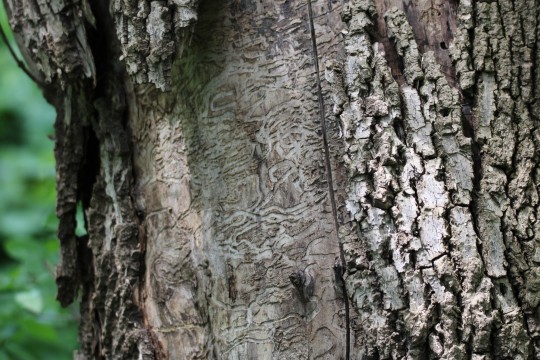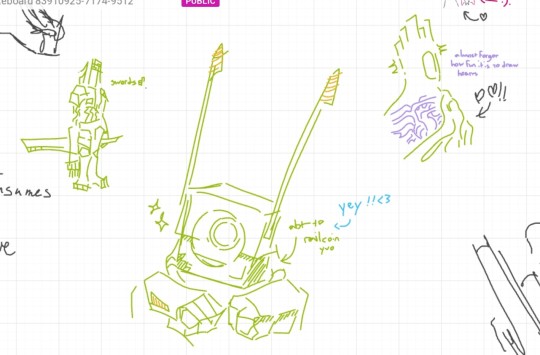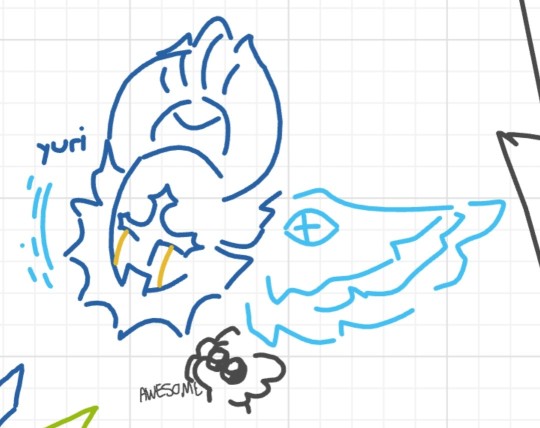#insect tracks
Explore tagged Tumblr posts
Text










Oil Beetle - Meloe campanicollis
When the autumn season arrives, I always try to seek out this specie of insect given it's size and uniqueness. As a reminder from earlier posts, this Beetle may be somewhat strange looking, especially if you consider the other members of its large family (Meloidae), but it is a Beetle nonetheless. At least it is easy to recognize given its bulbous abdomen, reduced wingcase and Ant-like head. Other Blister Beetles may have an Ant-like head, but they will possess functional elytra with wings and a long abdomen that protrudes from behind the wingcase (but doesn't bulge out). Keep an eye for these traits in the insect world, as the Beetles that possess them also come loaded with a burning hot defense. As such, handle with extreme care and make no attempt to agitate them. However, today's post won't cover the cantharidin defense of Oil Beetles (you can find more information by checking out this post here). Instead, we have two wandering female individuals (as confirmed by the antennae shape) to explore as they go about their dya. In Pictures 2 and 5, a hardy Beetle was crawling on some stones, and marched forward without a care for the impending chasm between the stones. Granted, insects are not stupid and can decide to turn or change direction if they detect their travel can go no further. In this case, I placed a leaf in her path to bridge the gaps and she crawled across to the other side. After crossing, she traveled the full length of the stone.... and then tumbled into the grass below after reaching the edge. I suppose there wasn't much to see/do from such a height.
For the second individual, she was likely searching for a suitable location to place eggs. Soil-filled and sandy environments are great places to look, but the chosen earth has to be a suitable depth in order to ensure that the many eggs have a degree of protection from predators and colder conditions. The sand she was traveling on definitely wasn't deep enough, and so she kept walking. She may be arching her body and placing her abdomen in the sand in Picture 7, but she's not testing for depth; this is a warning posture. After I backed off, she calmed down and resumed her walk, (and maybe you've noticed this already) she left a trail in the sand from where her abdomen touched the ground. This is a unique moment to how an insect makes tracks as it travels, both from her abdomen, and the three legs on each side making little indents (but mostly the former). As such, if you find trails like this, you may be able to follow the journey of such a beautiful insect as it moves. The trackway seems so small compared to the vehicle tracks next to her, but it's a real marvel. Unfortunately, it's also a necessity given the abdomen's size, so there's no lifting it off the ground. Of course, predators can follow this trackway, but they - assuming they followed the right direction - may not be prepared for the burning defenses that this Beetle possesses if caught!
Finally, having seen this Beetle specie a few times now, I've made small interactions with them on those occasions just to see how they react. While smaller insects tend recoil and retreat from the placement of a finger in front of or near then, the Oil Beetles I've found are always curious and begin to vigorous crawl up my finger, after which I pull away. If I find them next year, I'll try this again, but I'll be sure to have gloves on. I cannot emphasize enough that it is unwise to agitate or corner these Beetles since they can exude blister-inducing, cantharidin-saturated liquid from their joints. In addition to protecting yourself, don't allow dogs to prod or lick them while walking them.
Pictures were taken on October 17 and 21, 2024 with a Google Pixel 4. Next time this Beetle is showcased, we'll look at what happens after their eggs are placed in soil. It'll be a wild ride, unless you have to be a Bee!
#jonny’s insect catalogue#ontario insect#beetle#oil beetle#blister beetle#coleoptera#insect#insect tracks#toronto#october2024#2024#nature#entomology#invertebrates#arthropods#photography#animals
9 notes
·
View notes
Text

POV your existence disgusts those you try to cheer
#art#valentine's day#cupid#insects#angel#emetophobia#i've been trying to colour this one since december ahahah !!#irl work really has taken a lot of my time...#anyway this started out as an incredibly personal piece about how i feel when i get crushes#but i kinda lost track after a while... i'm not good at expressing ''myself''#i think i'm a good illustrator not a good artist !#my art
310 notes
·
View notes
Text
transphobes always make us sound so much cooler than we actually are. I wish I was some kind of society-toppling satanic eldritch abomination with an incomprehensible physical form instead of some guy who just spent his evening watching youtube videos about weird bugs and eating gardettos
#why is all bug drama just fucking nightmare fuel#they're all out there mind controlling each other and cooking each other alive and eating each other from the inside out#they're committing cannibalism and matriphagy and whatever is up with those beetles that are born pregnant#it's like if x-men was a horror series#that's not even getting into what fungi do to them#everything about bugs and how they live makes me question the existence of a loving god more than any personal misfortune ever could#this has gotten somewhat off track#but I am perpetually haunted by the knowledge that billions of insects are experiencing unthinkable horrors every day#and it's just normal for them
26 notes
·
View notes
Text

Emerald ash borer gallery (signs) on an ash tree. This species is highly invasive and destructive in North America. 5/22/24
#emerald ash borer#mine#invasive species#insects#invertebrate#invertebrates#bugs#insect#animal tracking#animal tracks#nature#wildlife#naturalist#nature photography#photography#ecology#north america#animals#ecologist#wildlife biology#wildlife biologist#biologist
20 notes
·
View notes
Text
please enjoy this bee

#bee#insect#bug#this is singlehandedly one of the best images ive captured#i saw a dusty bee and tracked it down to a flower and !! <3
15 notes
·
View notes
Text




sketches from @mipexch 's whiteboard a couple days ago!!
also feat. a very small reference to @onlineviolence :]
#peridots-art#bugs#bots#ultrakill#gabriel ultrakill#swordsmachine ultrakill#bugzapper ultrakill#minos prime ultrakill#v2 ultrakill#plus the rest of the fumos but those weren't done by me. someone was drawing v1 so i put a v2 beside them and came back later to like 5 mor#hence why they are out of frame. anyway this was a LOT of fun I lost track of time and stayed up till dawn even#there were so many cool and/or recognized artists.... i keep checking the ultrakill tag to see if anyone else posts their own sketches#it was posted at like 2am my time though so i didn't get to stay very long.... i checked in today on the fumo drawings and there was#just so much new art over there and in general. so many people doodling and having fun and complimenting each other and bonding over#the things we all like. im gonna cry#anyway. i think this is the longest period of non-posting (not inactivity. lol) on tumblr i've ever had#so might've forgot some tags. also i think i'll use alt text for multiple images and regular id for 1-2#edit also i wrote 'today' in the tags up there but it was in fact two days ago. regardless#ALSO. sorry if the alt text is hard to read or anything. never used it before + penchant for lengthy descriptions#can you tell i'm really proud of the beetle gabe btw. men will see a character say 'anyone gonna buggify that?' and not wait for an answer#WAIT i've already made that joke haven't i. whatever turn your blorbo into an insect or some sort of gay bug today#peridots-described
85 notes
·
View notes
Text







Compilation Of Additional Stream Beasts
16 notes
·
View notes
Text

#living up to the username! title track! cool bug pic!#photography#photographers on tumblr#feburary 2024#nikon d3200#nikon#snail#insect photography
17 notes
·
View notes
Text
I DO NOT WANT TO MAKE UKULELE MUSIC BUT IT IS WHAT I HAVE.
#random thoughts#AND IF I AM PIGEONHOLED INTO THE STEREOTYPICAL TRANSMASC MUSICIAN BOX I SHALL EAT YOUR EYES OUT.#there's piano too. and there will be whispering. and screaming. and various other sounds.............#would like to be more like the people who inspired me to make music (will wood stomach book malice mizer) but i guess i have to make do.#with my shit. oh well.#there are going to be so many sounds. 39 specifically is going to have subliminal messaging. and you might get some. insect noises in samsa#you can guess why for both of those. (how revealing!!)#also i feel like 39 should have a music video but i don't have anything to do it with. ):#i hope that ONE DAY my music shall exude. vampiric dissociative death spiral. a creature at the heart of the forest screaming secrets#but also just a boy who is tired of pretending at the end of it all. track 09 is just so intensely that.#i think my favorite song on the album is 39. which is ironic because it's about the one thing i don't tell people.#but it's so good i don't know. visceral. reflective of my style perhaps ?#there's a ticking metronome in the background that penetrates your ears and hurts you ! ! ! ! !#and i don't bother trying to be poetic. i use my long and tangled words and i make them vulgar and violent.#i also like affections & apologies because it's the opposite. it's sweeter. most importantly it's for ciel. that's what matters. {:#afterwards i plan on releasing a song composed entirely of poetic nonsense.
6 notes
·
View notes
Text




reigen plushie :3
#tw insects#tw cockroaches#tw bugs#ermmm. hoping i dont jumpscare anyone with the bug#reigen arataka#arataka reigen#mp100#mob psycho 100#reigen plushie#story behind the first image: my sister and i got lost walking to the train tracks lol
23 notes
·
View notes
Text



Cool guy I saw at work
#after this encounter a child peed in the tent set up in the children's area#and after that we discovered someone had diarrhea on their way out of the library and it had been tracked throughout the lobby#distant lowing#bugs#insect#beetle#grapevine beetle#I think
5 notes
·
View notes
Text
The loss of species diversity in northeastern forests of the United States similarly allowed tickborne pathogens to spill over into humans. In the original, intact northeastern forests, a diversity of woodland animals such as chipmunks, weasels, and opossums abounded. These creatures imposed a limit on the local tick population, for a single opossum, through grooming, destroyed nearly six thousand ticks a week. But as the suburbs grew in the Northeast, the forest was fragmented into little wooded plots crisscrossed by roads and highways. Specialist species like opossums, chipmunks, and weasels vanished. Meanwhile, generalist species like deer and white-footed mice took over. But deer and white-footed mice, unlike opossums and chipmunks, don't control local tick populations. When the opossums and the chipmunks disappeared, tick populations exploded.
As a result, tickborne microbes increasingly spill over into humans. The tickborne bacteria Borrelia burgdorferi first emerged in humans in an outbreak in Old Lyme, Connecticut, in the late 1970s. If left untreated, the disease it caused – Lyme disease – can lead to paralysis and arthritis among other woes. Between 1975 and 1995, cases increased twenty-five-fold. Today, three hundred thousand Americans are diagnosed with Lyme every year, according to estimates from the Centers for Disease Control. Other tickborne microbes are spilling over as well. Between 2001 and 2008, cases of tickborne Babesia microti, which causes a malaria-like illness, increased twentyfold.
Neither West Nile virus nor Borrelia burgdorferi and its kin can spread directly from one person to another, yet. But they continue to change and adapt. And elsewhere, the reordering of wildlife species that precipitated their spillover into humans proceeds. Globally, 12 percent of bird species, 23 percent of mammals, and 32 percent of amphibians are at risk of extinction. Since 1970, global populations of these creatures have declined by nearly 30 percent. Just how these losses will shift the distribution of microbes between and across species, pushing some over the threshold, remains to be seen.
— Pandemic: Tracking Contagions, from Cholera to Ebola and Beyond (Sonia Shah)
#sonia shah#pandemic: tracking contagions from cholera to ebola and beyond#science#virology#epidemiology#climate change#global warming#environmentalism#ecology#deforestation#animals#zoology#insects#entomology#usa#borrelia burgdorferi#lyme disease#ticks#chipmunks#weasels#opossums
12 notes
·
View notes
Text

And third one!
Animal Tracks is the youngest of the three I have so far. Like, couple months, probably. He's friendly but sometimes a bit overexcited and he will occasionally knock people over accidentally because he wants to give them, like, a quick hip-check as a greeting while passing them and using too much strength, and then you got a lot of insect made for battling monsters ramming into you. He means well tho.
4 notes
·
View notes
Note

Your kingfisher reminded me- have you seen him?
! ! ! ! I haven't worked on these guys so I didn't know their family name but i've seen them while walking around the shelves I love their tail feathers <3 here's one from paradisaeidae

#they were often quite beat up unfortunately tipically the type of birds we'd make perches for to avoid them just lying about#i want to say I made a perch for one of these maybe ? ? or maybe just a similar ones I was jumping around the shelves for the perches#for the cleaning part i was working sith the starting letters lol#i remember the corvidaes.... 2873467373737 crows i had to keep track of who was were and all of them looked so similar#almost lost one of them while he was in the freezer (insects)#and of course the alcerinidaes <3 darling kings#and the chloropseidaes ! ! ! ! ! ! ! ! ! whole chariots of green darlings#anyway thank you very much ! : ) love them#reareading this woagh the typos novody mill me pls
4 notes
·
View notes
Text

Aspen Serpentine Leafminer Moth, Phyllocnistis populiella
#animals tracks#tracks and sign#leafminers#moth#moths#wildlife#nature#insects#naturalist#nature photography#photography#mine#north america#ecology#ecologist#biology#biologist#wildlife biologist#wildlife biology#bugs
7 notes
·
View notes
Text
youtube
ren if you compressed him into an album
3 notes
·
View notes